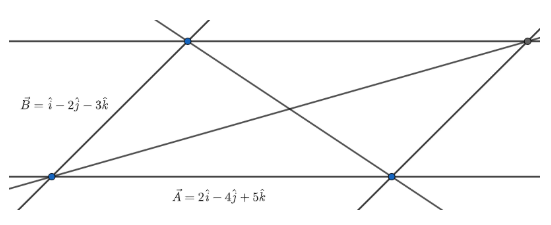
Two adjacent sides of a parallelogram are \[2\hat{i}-4\hat{j}+5\hat{k}\] and \[\hat{i}-2\hat{j}-3\hat{k}\]. Find the unit vectors parallel to both the diagonals. Also, find the area of the parallelogram.
Answer
605.1k+ views
Hint: Diagonal vectors of a parallelogram are the sum and difference of the adjacent side vectors. Area vector of a parallelogram is just the cross product between two adjacent sides.
Complete step-by-step answer:
Let \[\vec{A}=2\hat{i}-4\hat{j}+5\hat{k}\] and \[\vec{B}=\hat{i}-2\hat{j}-3\hat{k}\]

We know that if two adjacent vectors make a parallelogram then the principal diagonal vector is the sum of the two vectors and the other diagonal is the difference between two vectors. This is because of the triangle rule of addition of vectors.
The principal diagonal vector is, \[\vec{P}\] = \[\vec{A}+\vec{B}=(2\hat{i}-4\hat{j}+5\hat{k})+(\hat{i}-2\hat{j}-3\hat{k})=3\hat{i}-6\hat{j}+2\hat{k}\]
And the other diagonal vector is, \[\vec{Q}\] = \[\vec{A}-\vec{B}=(2\hat{i}-4\hat{j}+5\hat{k})-(\hat{i}-2\hat{j}-3\hat{k})=\hat{i}-2\hat{j}+8\hat{k}\]
We know that unit vector parallel to any vector\[\vec{R}\] is \[\dfrac{{\vec{R}}}{\left| {\vec{R}} \right|}\].
Hence, Unit vector parallel to \[\vec{P}\] = \[\dfrac{3\hat{i}-6\hat{j}+2\hat{k}}{\left| 3\hat{i}-6\hat{j}+2\hat{k} \right|}=\dfrac{3\hat{i}-6\hat{j}+2\hat{k}}{\sqrt{{{3}^{2}}+{{(-6)}^{2}}+{{2}^{2}}}}=\dfrac{3\hat{i}-6\hat{j}+2\hat{k}}{\sqrt{49}}=\dfrac{3}{7}\hat{i}-\dfrac{6}{7}2\hat{j}+\dfrac{2}{7}\hat{k}\] and unit vector parallel to \[\vec{Q}\] = \[\dfrac{\hat{i}-2\hat{j}+8\hat{k}}{\hat{i}-2\hat{j}+8\hat{k}}=\dfrac{\hat{i}-2\hat{j}+8\hat{k}}{\sqrt{{{1}^{2}}+{{(-2)}^{2}}+{{8}^{2}}}}=\dfrac{\hat{i}-2\hat{j}+8\hat{k}}{\sqrt{69}}=\dfrac{1}{\sqrt{69}}\hat{i}-\dfrac{2}{\sqrt{69}}2\hat{j}+\dfrac{8}{\sqrt{69}}\hat{k}\]
Now, we know that the area vector of a parallelogram bounded by two adjacent side vectors is the cross product between them.
Therefore, area of the parallelogram is \[\vec{A}\times \vec{B}=\left( \begin{matrix}
{\hat{i}} & {\hat{j}} & {\hat{k}} \\
2 & -4 & 5 \\
1 & -2 & -3 \\
\end{matrix} \right)=\hat{i}[(-4)(-3)-5(-2)]-\hat{j}[(2(-3)-(5)(1)]+\hat{k}[2(-2)-1(-4)]=22\hat{i}+11\hat{j}\]
Hence, the value of the area of the parallelogram is \[\left| \vec{A}\times \vec{B} \right|=\sqrt{{{22}^{2}}+{{11}^{2}}}=\sqrt{484+121}=\sqrt{505}\] units.
Note: Unit vector parallel to a vector means unit vector of that vector in that direction. Keep in mind while finding the area using cross product. The area vector may be negative but the modulus value will be positive only.
Complete step-by-step answer:
Let \[\vec{A}=2\hat{i}-4\hat{j}+5\hat{k}\] and \[\vec{B}=\hat{i}-2\hat{j}-3\hat{k}\]

We know that if two adjacent vectors make a parallelogram then the principal diagonal vector is the sum of the two vectors and the other diagonal is the difference between two vectors. This is because of the triangle rule of addition of vectors.
The principal diagonal vector is, \[\vec{P}\] = \[\vec{A}+\vec{B}=(2\hat{i}-4\hat{j}+5\hat{k})+(\hat{i}-2\hat{j}-3\hat{k})=3\hat{i}-6\hat{j}+2\hat{k}\]
And the other diagonal vector is, \[\vec{Q}\] = \[\vec{A}-\vec{B}=(2\hat{i}-4\hat{j}+5\hat{k})-(\hat{i}-2\hat{j}-3\hat{k})=\hat{i}-2\hat{j}+8\hat{k}\]
We know that unit vector parallel to any vector\[\vec{R}\] is \[\dfrac{{\vec{R}}}{\left| {\vec{R}} \right|}\].
Hence, Unit vector parallel to \[\vec{P}\] = \[\dfrac{3\hat{i}-6\hat{j}+2\hat{k}}{\left| 3\hat{i}-6\hat{j}+2\hat{k} \right|}=\dfrac{3\hat{i}-6\hat{j}+2\hat{k}}{\sqrt{{{3}^{2}}+{{(-6)}^{2}}+{{2}^{2}}}}=\dfrac{3\hat{i}-6\hat{j}+2\hat{k}}{\sqrt{49}}=\dfrac{3}{7}\hat{i}-\dfrac{6}{7}2\hat{j}+\dfrac{2}{7}\hat{k}\] and unit vector parallel to \[\vec{Q}\] = \[\dfrac{\hat{i}-2\hat{j}+8\hat{k}}{\hat{i}-2\hat{j}+8\hat{k}}=\dfrac{\hat{i}-2\hat{j}+8\hat{k}}{\sqrt{{{1}^{2}}+{{(-2)}^{2}}+{{8}^{2}}}}=\dfrac{\hat{i}-2\hat{j}+8\hat{k}}{\sqrt{69}}=\dfrac{1}{\sqrt{69}}\hat{i}-\dfrac{2}{\sqrt{69}}2\hat{j}+\dfrac{8}{\sqrt{69}}\hat{k}\]
Now, we know that the area vector of a parallelogram bounded by two adjacent side vectors is the cross product between them.
Therefore, area of the parallelogram is \[\vec{A}\times \vec{B}=\left( \begin{matrix}
{\hat{i}} & {\hat{j}} & {\hat{k}} \\
2 & -4 & 5 \\
1 & -2 & -3 \\
\end{matrix} \right)=\hat{i}[(-4)(-3)-5(-2)]-\hat{j}[(2(-3)-(5)(1)]+\hat{k}[2(-2)-1(-4)]=22\hat{i}+11\hat{j}\]
Hence, the value of the area of the parallelogram is \[\left| \vec{A}\times \vec{B} \right|=\sqrt{{{22}^{2}}+{{11}^{2}}}=\sqrt{484+121}=\sqrt{505}\] units.
Note: Unit vector parallel to a vector means unit vector of that vector in that direction. Keep in mind while finding the area using cross product. The area vector may be negative but the modulus value will be positive only.
Recently Updated Pages
Why are manures considered better than fertilizers class 11 biology CBSE

Find the coordinates of the midpoint of the line segment class 11 maths CBSE

Distinguish between static friction limiting friction class 11 physics CBSE

The Chairman of the constituent Assembly was A Jawaharlal class 11 social science CBSE

The first National Commission on Labour NCL submitted class 11 social science CBSE

Number of all subshell of n + l 7 is A 4 B 5 C 6 D class 11 chemistry CBSE

Trending doubts
What is meant by exothermic and endothermic reactions class 11 chemistry CBSE

10 examples of friction in our daily life

One Metric ton is equal to kg A 10000 B 1000 C 100 class 11 physics CBSE

1 Quintal is equal to a 110 kg b 10 kg c 100kg d 1000 class 11 physics CBSE

Difference Between Prokaryotic Cells and Eukaryotic Cells

What are Quantum numbers Explain the quantum number class 11 chemistry CBSE




